
A flower on a riverbank, La Selva, Costa Rica.
Swimming in rainforest rivers - Part 2
|
| Lakes and rivers of Pantanal, an area
of seasonally flooded savanna in Brazil and Paraguay, is one of the World's most
spectacular places for swimming. |
 |
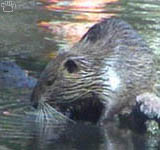 |
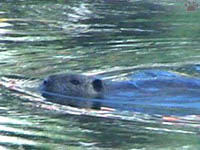 |
| Large rodents of Parana
river basin, left to right: plains viscacha (Lagostomus maximus)
and nutria (Myocastor coypus, 2 photos). Rio
Pilcomayo Nat'l Park, Paraguay/Argentina. |
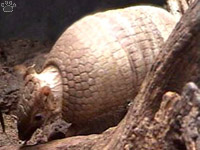
Three-band armadillo (Tolypeutes matacus),
Parque Nacional Rio Pilcomayo, Argentina. |
Water is usually too murky for snorkelling, but
you'll be surrounded by Jurassic-scale concentrations of large reptiles - mostly
caimans Caiman yacare and C. latirostris, but also anacondas, turtles
etc. |
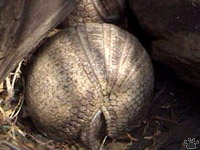
Three-band armadillo (Tolypeutes matacus),
Parque Nacional Rio Pilcomayo, Argentina. |
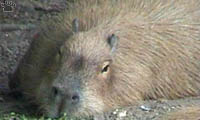 |
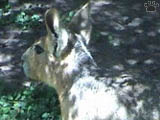 |
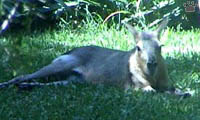 |
| Large rodents of Parana
river basin, left to right: capybara (Hydrochaeris
hydrochaeris), lesser mara (Dolichotis salinicola, 2 photos). Rio
Pilcomayo Nat'l Park, Paraguay/Argentina. |
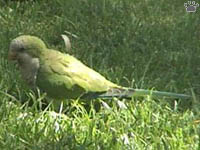
Monk parakeet (Myopsitta monachus),
Parque Nacional Rio Pilcomayo, Argentina. |
Pantanal attractions include immense
flocks of storks, herons and other birds, numerous large mammals, world's largest
leeches Haementeria ghilianii, two hundred frog species, and countless
other impressive wildlife. |
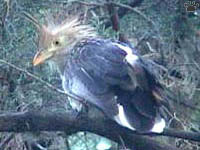
Guira cuckoo (Guira guira), Parque Nacional
Rio Pilcomayo, Argentina. |
 |
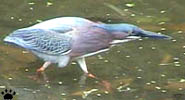 |
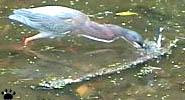 |
| Green heron (Butorides
striatus), Volcan Baru National Park, Panama. |
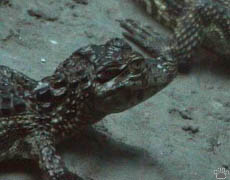
Pantanal caiman (C. latirostris), Parque Nacional
Rio Pilcomayo, Argentina. |
In the Amazon, the crocodilians you
most often encounter in rivers are white caimans (C. crocodylus crocodylus).
They are strictly nocturnal. |

Pantanal caimans are generally harmless. Parque Nacional
Rio Pilcomayo, Argentina. |

American crocodiles (Crocodylus
acutus) and one Spectacled caiman
(Caiman crocodylus mexicanus,
with orange-tinted eyes), Santa
Rosa National Park, Costa Rica. |
Larger black caimans (Melanosuchus niger) are more common
in oxbow lakes. I have encountered them many times, day and night, but they never
showed any sign of aggression. In Orinoco basin this species is replaced by Orinoco
crocodile (Crocodylus intermedius), also said to be dangerous, but extremely
rare. In Central America, there are also caimans and crocodiles, but they are
not so large. |
 |  |  | | Freshwater stingrays
(Potamotrygon motoro), Manu National Park, Peru. |
| Other dangers of tropical rivers are also overestimated.
It is a good idea to wear a t-shirt and light pants - small fishes sometimes like
to bite protruding parts of your body. Tight swimming suite will protect you from
infamous candiru - tiny catfish, parasiting in urinary tract of large fish.
Try to avoid river bottom when possible - there are logs and stingrays (freshwater
stingrays, by the way, are among the world's most beautiful fishes). Do not enter
places with too fast current, and always move slowly in small creeks with muddy
bottoms - beware of electric eels. |
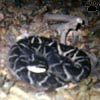
Bothrops pit vipers are
the only poisonous
snakes in Amazon you
can sometimes see
without special effort. |
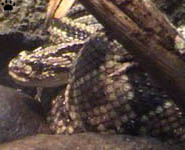 | 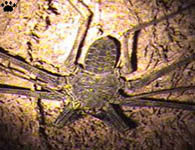 |
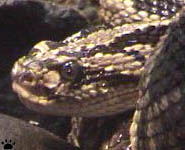 |
| Tropical rattlesnake (Crotalus dirissus) and a giant whipscorpion, Braulio Carillo National Park, Costa
Rica. |
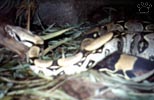
Common boa (Boa constrictor),
Jumandi Caves, Ecuador. Giant
snakes - anacondas and pythons - can
be potentially dangerous, but your
chances of being attacked are minimal. | Parasites are mostly present downstream from farms and villages;
it's a good idea to have some metronidazol-based pills in your backpack. There
are also parasites in lakes, but diving there is worth the risk: lake water is
often transparent enough to see fish and other creatures, and there is even more
wildlife around lakes, than on river banks: giant otters, goatzins, ad infinitum.
The main danger in any rainforest are mosquitoes, but you avoid most of them (and
gnats, and blackflies, and sandflies, and leeches, and ticks, and vampire
bats) simply by getting into the water. |
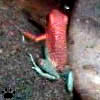 |
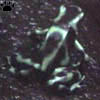 |
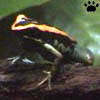 |
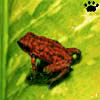 |
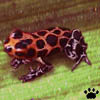 |
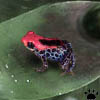 |
Poison-dart frogs,
upper row, left to right: Dendrobates granuliferus, D. auratus,
Phyllobates vittatus (Costa Rica), D. histrionicus, D. intermedius
(Colombia), middle row -D. reticulatus, Epipedobates parvulus (Ecuador),
bottom row - Ph. terribilis, D. leucomelas, D. tinctorius
(Venezuela), E. tricolor, D. lamasi (Peru). |
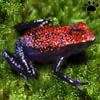 |
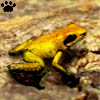 |
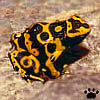 |
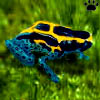 |
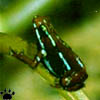 | 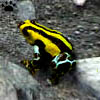 |
| Foothill and mountain rivers are particularly challenging. Usually,
you can find maximum biodiversity in rainforests at elevations 500-1500 m, but
rivers can be very cold and dangerous here. Local people can sometimes tell you
what parts of a river are the safest. The advantage of mountain rivers is that
there are almost no dangerous animals or parasites here, and you can sometimes
travel very fast. The only crocodiles here are dwarf caimans (Paleosuchus).
Water can be very clear, so sometimes it is a good idea to have a mask on - you'll
get better view of underwater obstacles, not to mention underwater fauna. If the
river is too unsafe for swimming, floating in a small canoe can also get you close
to animals on the banks, although not as effectively. | 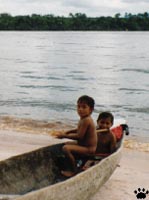
Children of Bosque de Coca Indians,
Rio Magdalena, Colombia. |
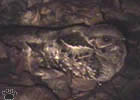 | 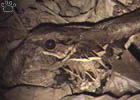 |
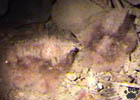 | 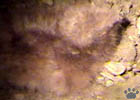 |
| Pauraque nightjars (Nyctidromus
albicollis) - male, female on a nest, and two chicks. Corcovado Nat'l Park,
Costa Rica. |
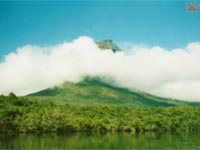
Tepui plateaus, Canaima River, Venezuela. |
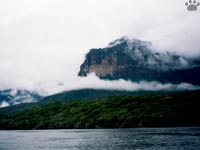 | Some foothill rivers are very
beautiful, such as rivers of Guyana Highlands, where you can see fantastic tepui
landscape and World's tallest waterfalls. |
| Most high-elevation rivers are too fast to swim in, but if you
have a wet suit, or can tolerate cold water for a while, you can use mountain
lakes instead. Lake Titicaca in South America is an excellent place to observe
rare birds, amphibians and fishes. Here you can swim, paddle in a traditional
boat made of totora (tule Scirpus californicus), or use man-made islands
as moving blinds to see flightless grebes and other wildlife. | 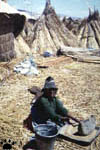
Village of Uros Indians
on a floating island. | 
Lake Titicaca near
Sullistani, Peru. |
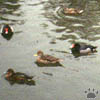
Rosy-billed pochards
(Netta peposaca), Lago
Todos Los Santos, Chile. | 
Lake Ninyococha, Ecuador,
habitat of woolly tapir
(Tapirus pinchaque). | 
Sunrise in cloud forests
around Lago Muerte,
Costa Rica. | 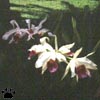
Cattleya paloma, one of
250 orchid species of
Lago Iguaque, Colombia. |

Morning,
Chitwan National Park, Nepal. |
Trying this method in Southern China
and in the terai of Nepal,
I got mixed results. In Yunnan, tropical forests are completely cleared along
Mekong and other large rivers, so you can only use small forest streams. You mostly
have to walk here, not swim, but it is also a good way to see wildlife. Forests
of lowland Nepal are more dry, open and road-crossed, and most of large animals
are so accustomed to people that you can simply walk by. There are two species
of crocs, but gharial (Gavialus gangeticus) feeds almost entirely on fish,
and mugger (Crocodylus palustris) is more common in lakes and ponds. Unfortunately,
most rivers in Southern China and Nepal are heavily polluted, and in India the
situation must be even worse. |
Still, I could see some nice animals on river banks - rhinos,
deer, gharials, ghaurs, fishing cats, splendid
tiger pythons, dozens of huge monitor lizards, as well as kingfishers and other
beautiful birds.
| 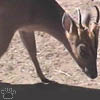 | 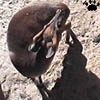 | Muntjak deer (Muntiacus
muntjak)
on a beach, Chitwan, Nepal. |
| 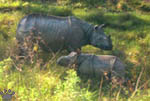
Indian rhinoceros (Rhinoceros
unicornis), Chitwan, Nepal. |
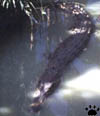
Philippine crocodile,
Kata Swamp, Palawan. | The situation is much worse on the Philippines,
where virtually all river valles are cultivated, and unique native fauna is clinging
to existance in tiny patches of remaining forests, mostly on mountain tops. Only
on one island, Palawan, could I find few small forested rivers, and such local
endemics as Philippine crocodile (Crocodilus mindorensis). The larger species,
saltwater crocodile (C. porosus), seems to be already extinct. Some of
the best rivers are in St. Paul National Park, including a special treat - 20-km
long underground river with stunning diverity
of fauna. |
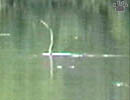 | 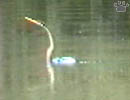 | 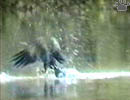 | 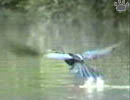 | | Darter (Anchinga
melanogaster), Kinabatangan River, Sabah. |
| One famous place to see animals from water is Kinabatangan
River in Malaysian Borneo. Motorboat rides are a popular tourist attraction
there, but you'll see more wildlife by swimming or paddling in a small dugout
boat. Waterbirds, monkeys, otters, and kingfishers are most commonly seen, but
dense vegetation around smaller channels and oxbow lakes shelter also civets,
hornbills, orangutans, pythons, and countless other inhabitants. | 
Flooded forest, Kinabatangan. | 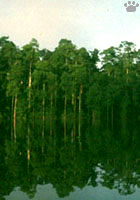
Oxbow lake, Kinabatangan. |
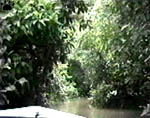
Traveling through flooded forest. | During the wet season (October-March), forests along Sugai Kinabatangan
are mostly flooded, so you can easily swim or paddle around. Don't forget your
mask - the water is full of barbuses and other beautiful fishes.
I'd really like to float the entire length of Lower Kinabatangan some day. A trip
from the highway bridge where forests begin to the river mouth should take a few
days in a kayak. |
 |  | 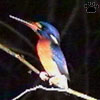 | 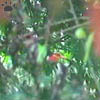 | | Kingfishers of Malaysian
rivers, left to right: Alcedo euryzona, A. meninting (two pictures), A.
rufidorsa. |
| Forest rivers of Sichuan are clear, but fast.
You can see some of the World's rarest animals here, such as both pandas, many
pheasants and dozens of small mammals few people have ever seen, but you have
to be a good swimmer and make sure there are no waterfalls or rapids downstream.
You'll probably need a wetsuit, and a lot of paperwork to deal with locals. Unfortunately,
these rivers are usually flooded throughout the warm season - first from snowmelt,
and then from monsoon rains and thawing glaciers. | 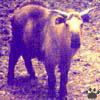
Takin (Budorcas
taxicolor), Wolong
Nat. Park, Sichuan. |
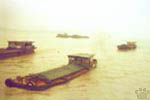
Houseboats on Yangtze River, China. | Side channels and bayous of lower Yangtze River were once an
excellent place to see wildlife by swimming. Now they are all destroyed, and the
river itself is dammed and polluted. In 1993, it was still possible to swim in
Wuhu Nature Reserve, and to see rare birds, fish, deer, dolphins and alligators.
I do not know what does this place look like now. |
| Further north, Amur
and Ussuri rivers have interesting fauna, in the water as well as on riverbanks.
But the Russian/Chinese border mostly follows them, so the best parts are off-limits.
Swimming in small forest rivers of Ussuriland
in summer can also be very interesting. As everywhere, it should be done at night
or at dusk as often as possible, because most forest mammals are active at night.
Morning hours are better for birds, and midday for some reptiles. In Ussuriland,
Siberian tiger is the top prize, but don't count
on it. |
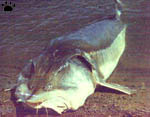
Giant kaluga sturgeon (Huso
dauricus), Amur River, Russia. |

Blackwater bayou in baldcypress
forest, Okefenokee Swamp, USA. | Probably the best place outside the tropics to see wildlife by
swimming is in Southeastern United States. This area has
outstandingly diverse freshwater fauna. Baldcypress forests and blackwater bayous
(side channels) of local rivers are very beautiful, but there are so many mosquitoes
and blood-sucking flies in summer, that staying in the water is the only way to
explore them comfortably. This ancient world can be seen in Nature reserves of
Florida, Gulf Coast, parts of Georgia and the Carolinas. Water is usually warm
here from late spring to mid-autumn. In colder months, you can get around in a
canoe. By visiting the area in winter, you will avoid mosquitoes and be able to
see terrestrial animals through leafless forest, but miss amphiumas, sirens, turtles
etc. |
Animals
in USA
are often
relatively
tame and
easy to
approach. | 
North American otter (Lontra
canadensis), Okefenokee, USA. | 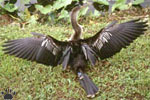
Anhinga (Anhinga anhinga),
Everglades, USA. | 
Swamp rabbit (Sylvilagus aquaticus),
Guadalupe River, USA. |

Alligator,
Atchafalaya River, USA. |
Alligators (Alligator mississippiensis), snakes and giant
snapping turtles are abundant in these rivers, but you are not at serious risk,
unless you try to catch them, or you are a small kid. If you want to avoid encountering
too many reptiles, try swimming at dawn, when the air is cool, or choose narrow
channels - there you'll have better chances of seeing them first. Alligators seldom
attack to kill, and snakes never attack first at all. Carrying a wooden stick
will make you feel more confident, and help you float. |
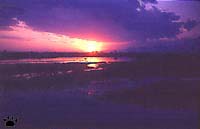
Sunset on Kwati River, Chitwan National Park, Nepal.
Part 3
Back to Part 1
Home
|

